

Vol. 40 (Number 20) Year 2019. Page 27
YUSUPOV, Kasim N. 1; TIMIRYANOVA, Venera M. 2; POPOV, Denis V. 3 & TROFIMOVA, Natalia V. 4
Received: 27/03/2019 • Approved: 03/06/2019 • Published 17/06/2019
3. Analyzing the achieved values of indicators for the mu located in adjacent territories
ABSTRACT: The heterogeneity of the economic space is often found in the differences related to the development of central regions and areas located along borders. In this paper the authors have made an attempt to quantify the impact of the location of a municipal unit (MU) near the borders of the Russian subject and its hierarchical subordination on its socio-economic state. For this purpose, the tools used in the hierarchical analysis, including those in other scientific areas, and allowing to analyze group and intergroup relations (HLM – Hierarchical linear modeling) were applied. The groups have been singled out according to belonging of the MU to a Russian subject and its location (in the center or at the border of the subject). In the paper 334 MU located in seven subjects (regions) have been analyzed. One hundred and ninety-four of them are located on the territory with an interregional border. The obtained results generally indicate the applicability of these tools in spatial analysis. The calculations made it possible to define the impact of the location on the achieved values of the indicators and quantify its importance. In the course of the data analysis, it has been determined that the location and hierarchical subordination of the MU have a different degree of impact on various indicators. |
RESUMEN: La heterogeneidad del espacio económico se encuentra a menudo en las diferencias relacionadas con el desarrollo de las regiones centrales y las áreas ubicadas a lo largo de las fronteras. En este artículo, los autores intentaron cuantificar el impacto de la ubicación de una unidad municipal (MU) cerca de las fronteras del sujeto ruso y su subordinación jerárquica en su estado socioeconómico. Para este propósito, se aplicaron las herramientas utilizadas en el análisis jerárquico, incluidas las de otras áreas científicas, y que permiten analizar las relaciones de grupo e intergrupo (HLM - modelado lineal jerárquico). Los grupos se han destacado de acuerdo con la pertenencia de la MU a un sujeto ruso y su ubicación (en el centro o en el borde del sujeto). En el documento se han analizado 334 MU ubicadas en siete temas (regiones). Ciento noventa y cuatro de ellos se encuentran en el territorio con una frontera interregional. Los resultados obtenidos generalmente indican la aplicabilidad de estas herramientas en el análisis espacial. Los cálculos permitieron definir el impacto de la ubicación en los valores alcanzados de los indicadores y cuantificar su importancia. En el curso del análisis de datos, se ha determinado que la ubicación y la subordinación jerárquica de la UM tienen un grado diferente de impacto en varios indicadores. |
The external differentiation of territories and internal inequality of their development are the two most frequently raised problems in the regional economy. This is due to the fact that the socio-economic situation of both regions and individual settlements located in them varies at different rates under the impact of various factors. These two problems are rarely considered comprehensively. As a rule, when the differentiation of regions and countries is studied, their advantages and disadvantages are compared. In case of analyzing internal inequality, the causes and factors of its occurrence are compared.
At the same time, a center and periphery can be distinguished within any territorial unit (a settlement, a city, an area, a region, a region-subject, a district, etc.). In accordance with natural causes challenged by a higher population density, the most active socio-economic development is observed in central parts of the territories. The periphery is usually located on the border of a territorial unit and horizontally interacts with the periphery of the neighboring territorial unit (Erkut & Özgen, 2003). As a rule, the current studies touch the problems on the cooperation in the border areas of different countries in order to improve the connectivity of the territories (Gualini, 2003; Perkmann, 2003; Decoville et al., 2013; Chilla et al., 2012; Fomin, 2010). In the countries with large territories, such studies aim at studying the effect of the interregional border (Dube et al., 2010; Lukin & Uskova, 2016; Nitsch, 2003).
This study aims at expanding ideas about the development of the MU located along the borders and in the center of the subjects of the Russian Federation. It is based on applying the tools that until recently have been used in other scientific areas to assess intergroup and interclass differences. The effect of the territory location along the border or in the center to achieve certain results can be defined by using multilevel hierarchical analysis due to including a categorical variable that is responsible for belonging of the MU to the territory with an interregional border. The study of interregional differences at the level of MU, taking into account their spatial location, will allow more reasonably expanding the interregional cooperation and improving the connectivity of the territory.
The study of the impact of the MU location on its development must take into account rather many factors. In this paper, only two factors are taken into account: the location in regard to borders and the hierarchical subordination to one of the Russian subjects. In order to be able to take into account the location in regard to interregional borders, all MU within each Russian subject were divided into two groups. The first one included the MU located in the central part, and the second group included those located on the periphery, on the border with other subjects of the Russian Federation. This classification makes it possible to form a hierarchical structure of the territory under study.
Figure 1
Hierarchical structure of the territory under consideration
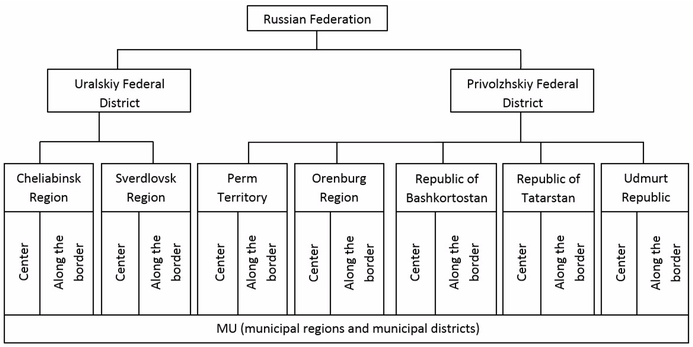
The offered formulation of the problem allows applying the multilevel analysis methods to evaluate the impact of the group effect and the MU location on their development. Singling out the hierarchical subordination of MU by their location in regard to interregional borders of the Russian subjects as a separate level is an artificial formation of groups. The results of such grouping can be quite controversial, and the obtained results must be widely discussed. However, they are required for determining the possible boundary effect by using hierarchical analysis tools.
At the first stage, the hypothesis about the intergroup differentiation, i.e. differences among the MU in the achieved values of indicators depending on the location (center/along the border) and belonging to a particular Russian subject was tested. In order to do this, average values and variations of the indicators of the socio-economic development in the MU through the example of seven constituent entities of the Russian Federation were calculated. After that, the authors used the approach of H. Moellering and W. Tobler (Moellering & Tobler, 1972) who had noted that the geographical hierarchy had been ordered by the size of the areas that could have been taken as a scale unit. According to them, the data analysis at different levels of the hierarchy is equivalent to the data analysis at different geographic scales. When applying this approach, it is necessary to take into account the fact that the current division of territories is far from the ideal structure offered by V. Christaller. The results obtained on the impact of each level should be interpreted with a great caution due to the heterogeneity of the data of the nested structure. In addition, there are clear requirements for the hierarchy under analysis. Firstly, the hierarchy must be fully nested (i.e. the MU may belong to only one subject of the Russian Federation). Secondly, the branches in the hierarchy must be of the same length for each MU. Thirdly, “local inversions” are not allowed in the hierarchical tree.
At the second stage, the hypothesis that the value of the indicator is determined by the effects on three levels was tested:
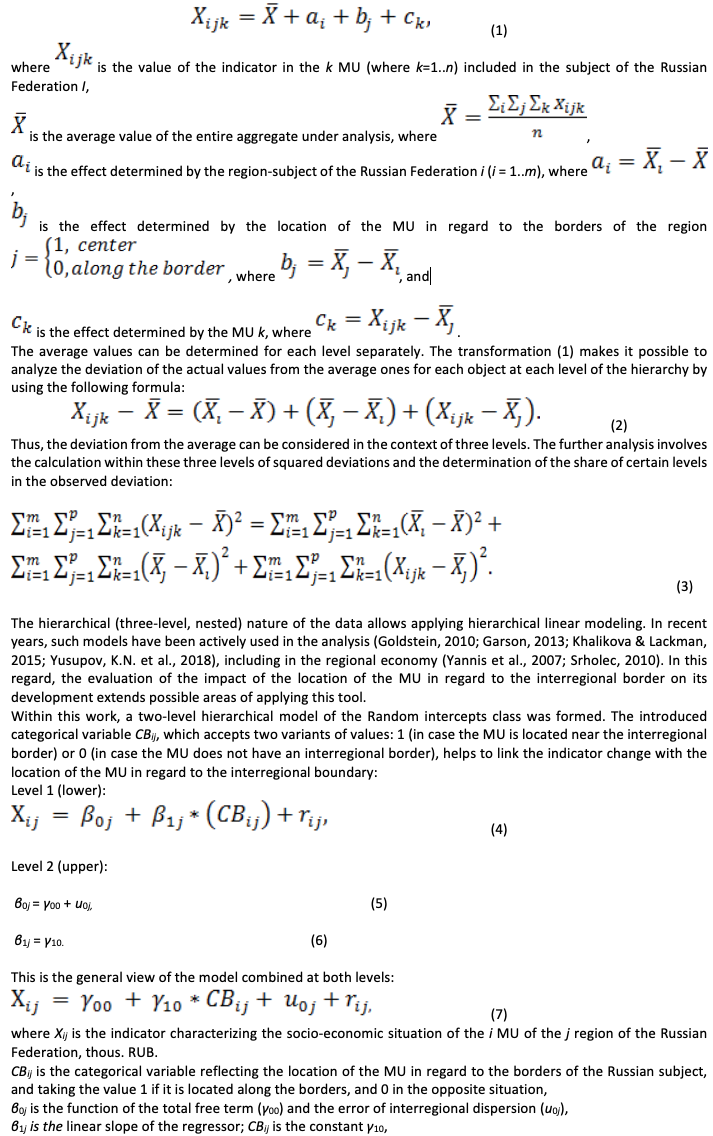
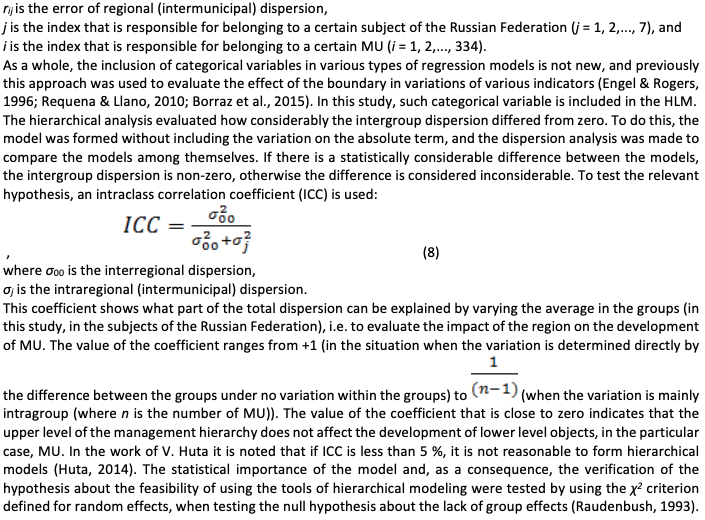
In their work the authors used the indicators of 334 MU located in seven subjects (regions) belonging to two federal districts of the Russian Federation. One hundred and ninety-four of them were referred to as the MU located on the territory that contains an interregional border. The analysis excluded the closed cities because of the peculiarities of their development and the lack of data on some indicators.
Seven out of 85 subjects of the Russian Federation under consideration are characterized by the conditional border between the European and Asian parts of the country. Their total area is 819.6 thousand km2. In these seven subjects of the Russian Federation there are 21.9 million people, which is almost 14.9 % of the total population of the country. In ratings three of seven regions under analysis are often found in top ten of the best subjects of the Russian Federation.
Three indicators were analyzed for the subjects of the Russian Federation under consideration:
¬ – Social payments and taxable money income of the population on average per one resident of the MU in 2016, thous. RUB/person,
– Shipped goods produced locally, performed works and services by own efforts (excluding small entrepreneurship) as per one person in the MU in 2016, thous. RUB/person,
– Investments in fixed capital (excluding budgetary funds) per one person in 2016, thous. RUB/person.
The values of the indicators collected by the Federal State Statistics Service correlate with the indicators most often used to evaluate the socio-economic development of a territory. The first indicator characterizes the standard of living, the second – the production development, and the third – the investment activity of MU. These three aspects are most often analyzed when studying the development of territories (Sinelnikov-Murylev, 2017) and are taken into account in the ratings of Russian subjects (Rating of socio-economic status of subjects of the Russian Federation according to the results of 2017).
The presented average values and variation of indicators in the context of the subjects of the Russian Federation, singling out the peculiarities of the indicator in the MU located on the contact line with a neighboring subject of the Russian Federation, clearly distinguish the following feature: the MU located in adjacent territories have lower value of the indicator.
Table 1
Indicators as calculated per one resident
of the mu in 2016, thous. Rub/person
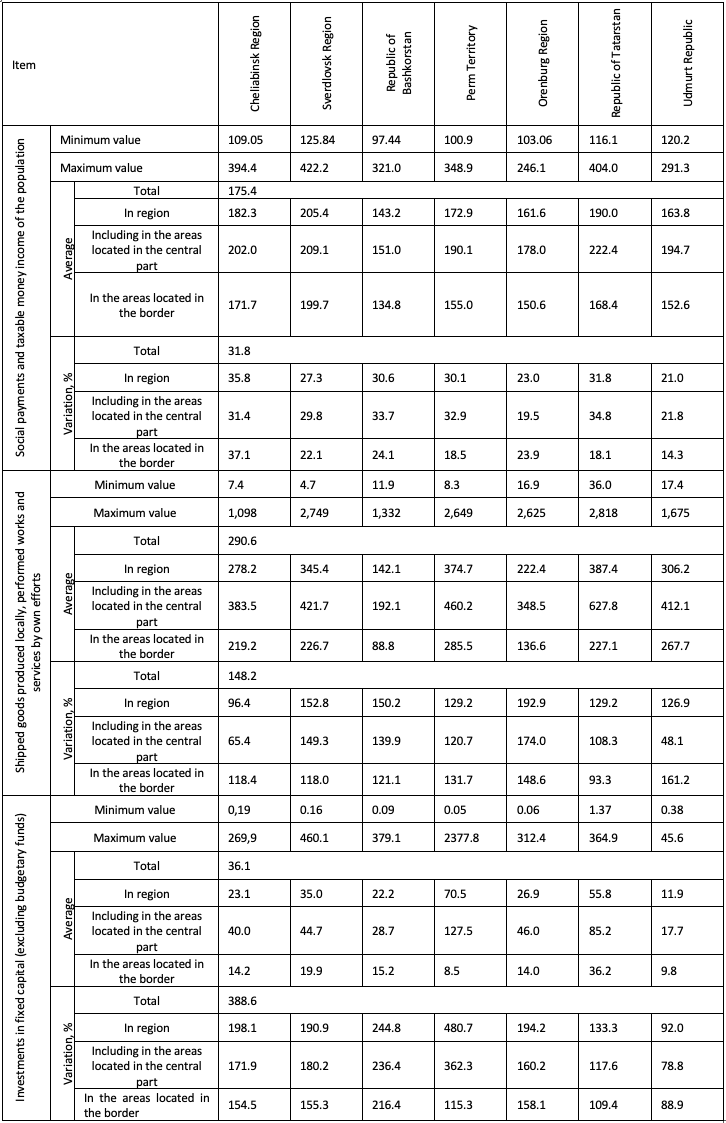
The analysis of the average values showed the differentiation of the MU in the context of the subjects of the Russian Federation. The MU located on the border between subjects of the Russian Federation are quite far behind as compared to the MU located in the center by the achievable values of indicators. At the same time, the variation of the indicators in the MU located on the interregional border may be stronger than the variation of the MU located in the center. This is largely determined by the differences imposed by the MU located on the other side of the interregional border, and controlled by another subject of the Russian Federation.
The regional power within the general vector of development determined by the national power makes decisions that make it possible to most efficiently use the existing potential of the territories. The development of each local area (MU) depends on the way they explain the general concept of the federal government to a lower level of government (municipal, local) and link it with the capabilities of the region. However, Jing Pan notes that “higher level policies can be possibly interpreted into a locally differentiated version upon local government’s discretion and objectives and hence be implemented differently” (Pan, 2014). Thus, the regional authorities can not only implement various activities, but also conduct the same activities differently. As a consequence, the MU managed by different subjects of the federation may have different tasks and development programs. The neighborhood of such MU divided by a conditional border between the subjects of the Russian Federation, influencing their development, may determine their higher variation in comparison with the MU located in the central part.
According to the method of H. Moellering and V. Tobler (1972), the impact of the regional power and belonging of the MU to the territory containing the interregional border on the values of indicators achieved by them was evaluated. The most important gap is observed between the MU located in the central part and on the periphery of the subject of the Russian Federation in terms of the shipped products and investments in fixed assets in the Republic of Tatarstan and the Sverdlovsk Region. Even though the values of indicators in the adjacent territory of these subjects of the Russian Federation are higher than those of their neighbors, the central part develops several times better. Thus, on average, in the Republic of Tatarstan, in the districts located in the central part, the volume of products shipped per capita is 627.8 thous. RUB/person, and in the areas that are adjacent to other regions of the Russian Federation this is 227.1 thous. RUB/person. At the same time, the value of the indicator in the adjacent territories of two neighboring subjects of the Russian Federation is even lower (in the Republic of Bashkortostan – 88.8 thous. RUB/person, and in the Orenburg Region – 136.6 thous. RUB/person).
In order to determine the importance of the impact of the location and hierarchical subordination on the socio-economic development of the MU, the sum of squared deviations of indicators for the MU from the average one by all three indicators was determined. The greatest variation is observed at the level of the MU. For the indicator “Investments in fixed assets”, the location (center/ along the border) is practically unimportant. On the contrary, the variation of social payments and taxable money income of the population on average per one resident of the MU is determined by 14.4 % by the subject of the Russian Federation and by 7.4 % by its location: in the central part or along the interregional border.
Table 2
Sum of squared deviation in terms of singled out levels
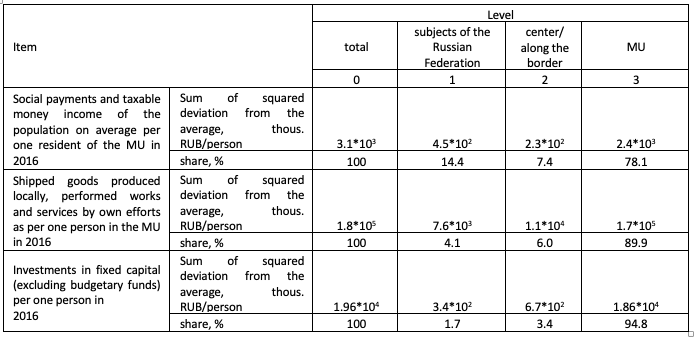
In order to confirm the hypothesis about the impact of the location on the achieved values of the indicators, hierarchical linear models were made. The results of the calculations confirmed the hypothesis about the importance of the impact of the boundary for the indicators “Social payments and taxable money income of the population on average per one resident of the MU” and “Shipped goods produced locally, performed works and services by own efforts as per one person in the MU”. The p-value values are above 0.5, and the low rate of likelihood for the indicator “Investment in fixed assets (excluding budgetary funds) per one person” indicates that there is no impact of the interregional border on it.
Table 3
Results of forming HLM
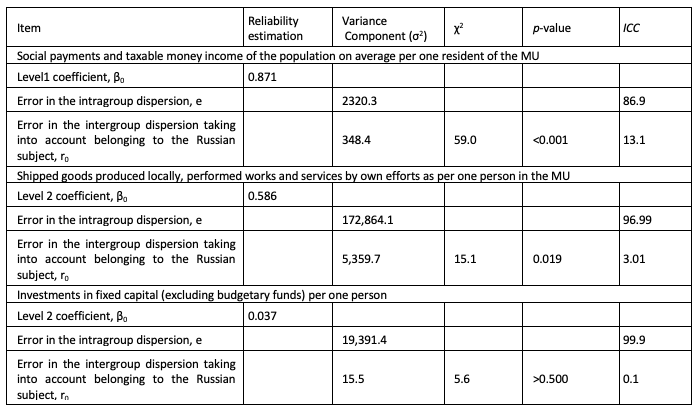
For the indicator “Social payments and taxable money income of the population on average per one resident of the MU” belonging to one of the seven Russian subjects determines 13.1 % of the variation of the indicator, and this is 3.01 % for the indicator “Shipped goods produced locally, performed works and services by own efforts as per one person in the MU”.
The model included the categorical variable “border (CB, cross-border)” that within the multilevel linear regression showed the impact of belonging of the MU to the territory containing the intermunicipal border on the indicator variation. Table 4 shows the evaluation of fixed effects for this variable.
Table 4
Final estimation of fixed effects with robust standard errors
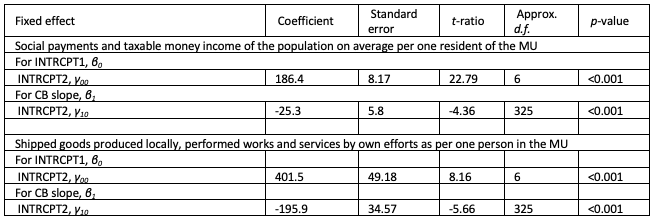
The negative value of the coefficients γ10 under the categorical variable CBij in both models indicates the negative impact of the location of the MU along the borders of the Russian subject on the achieved values of the indicators. Accordingly, the location in the center contributes to obtaining higher values of indicators of the socio-economic development of the MU.
The space heterogeneity is determined by many factors. This study focuses on identifying differences in the development of the MU located along the interregional border and those located in the center of the region as well as defining the importance of the interregional boundary in the detected heterogeneity of the territory under these conditions. The differences in the development of territories located along borders are found in many countries (Dube et al., 2010). It is often noted that “border regions are mostly located in the periphery of the countries” (Erkut & Özgen, 2003). This situation, when the bordering region is peripheral at the same time, is related to the fact that earlier when determining the location of many economic entities, preferences were given to the central parts of the regions. Now, in order to change this situation, measures are actively taken to develop border areas, eliminate barriers between territories, and develop interregional cooperation (Gualini, 2003; Perkmann, 2003; Decoville et al., 2013; Chilla et al., 2012). The efficiency of such measures can be improved as a result of preliminary and subsequent evaluation of the impact of the location in regard to the interregional border on the variation of certain indicators of the MU.
This study tested the possibility to make such evaluation by using hierarchical analysis methods. The calculations made it possible to define differences between the MU located in the central part and along the border of the region. To a certain extent, it is possible to state that they helped to determine the importance of being located in the central part of the Russian subject and the impact it has (negative or positive) on the indicators of the socio-economic development achieved by the MU. However, it is necessary to treat these conclusions with caution, because only three indicators for one year had been considered, and one of them showed rather low results of evaluating the quality of calculations. The validity of the results would be more reliable if a larger number of indicators were covered and their changes were considered over time.
It is necessary to interpret the results of modeling with caution if it is determined that they are not important. Thus, the calculations on one of the considered methods of hierarchical analysis showed that according to the indicator “Social payments and taxable money incomes of the population” the location along the interregional border determines 7.4 % of the indicator variation, while according to the indicator “Investment in fixed capital” – only 3.4 %. The analysis made by using another method allowed defining the negative nature of the impact of the location on the achieved values of the indicator
“Social payments and taxable money incomes of the population”. It was impossible to define such effect according to the indicator “Investments in fixed assets”, because when modeling, it was not possible to obtain statistically significant results of the impact. Is this an indirect evidence of the fact that the interregional border and belonging of the MU to various Russian subjects are not important? This conclusion is supported by the fact that, in recent years, in order to level the socio-economic development, the tendencies of selective investment in depressed areas and municipal areas located on the interregional border have been highlighted in the policy of supporting investment activity. Such work is carried out in all regions of the country. As a whole, this could have an impact on the revealed inessentiality of the location along the interregional border and belonging to certain Russian subjects.
It is also necessary to note that one of the methods of hierarchical analysis provided grouping by the location in regard to the borders of the Russian subject as a separate level. This is an artificial formation of groups based only on the territorial location of the MU that are under the overall control of the Russian subject, and a necessary step in the hierarchical analysis. This must also be taken into account when making conclusions. At the same time, the territory of the Russian subject located at the border is not always a periphery. Accordingly, in further studies, it is possible to regroup the MU based on evaluating their socio-economic status in order to single out the core and its neighbors of the first, second and third order. This will allow assessing the importance of the territory location in regard to the core, but not to the borders of the Russian subject.
As a result of the study, it has been determined that the methods of analyzing the regional development can be extended by using the tools previously applied in other scientific areas. In the study the MU located on adjacent territories and hierarchically subordinating to the subjects of the Russian Federation can be considered in terms of their intergroup and intragroup variations. Based on the variation values, the intergroup and intragroup dispersion, interclass correlation coefficient and other indicators obtained during the calculations, the following conclusions have been made for seven analyzed subjects of the Russian Federation:
– The socio-economic status of the MU depends on its location in regard to the borders of the Russian subject and its hierarchical subordination. The MU located on the border of Russian subjects lag behind by the achieved values as compared to the MU located in the center,
– The location and hierarchical subordination of the MU is the most important for the indicator “Social payments and taxable money income of the population on average per one resident of the MU”,
– The location and hierarchical subordination of the MU are of the least importance for the indicator “Investments in fixed assets (excluding budgetary funds) per one person”, which is largely defined by the selective investments in developing the territories outlying from the center that is observed in many regions of the Russian Federation, and
– Due to including the categorical variable “cross-border”, which is responsible for belonging of the MU to the territory containing the interregional border, the negative impact of the location along the borders on the considered indicators of the socio-economic development of the MU was determined.
The possibility of using the methods of hierarchical analysis, including multilevel regression modeling, to study the development of adjacent territories remains controversial. However, their use will allow taking management decisions on the basis of quantitative evaluations of the importance of the location of the unit under study in regard to the borders of the territory and its hierarchical subordination. In its turn, this will allow a reasonable approach to forming interregional relations at the level of the MU located in adjacent territories.
The reported study was funded by RFBR according to research project No. 18-010-00668 A "Government Regulation of Municipal Districts Based on the Hierarchical and Spatial Models".
Borraz, F., Cavallo, A., Rigobon, R., & Zipitria, L. (2015). Distance and Political Boundaries: Estimating Border Effects under Inequality Constraints. International Journal of Finance & Economics, 21(1), 3–35. doi:10.1002/ijfe.1517
Chilla, T., Evrard, E., Schulz, C. (2012). On the Territoriality of Cross-Border Cooperation: “Institutional Mapping” in a Multi-Level Context. European Planning Studies, 20(6), 961-980. doi: 10.1080/09654313.2012.673563.
Decoville, A., Durand, F., Sohn, C., Walther, O. (2013). Comparing Cross-border Metropolitan Integration in Europe: Towards a Functional Typology. Journal of Borderlands Studies, 28(2), 221-237. doi: 10.1080/08865655.2013.854654.
Dube A., Lester T. W., Reich M. (2010). Minimum Wage Effects Across State Borders: Estimates Using Contiguous Counties. IRLE Working Paper No. 157-07. Retrieved from http://irle.berkeley.edu/workingpapers/157-07.pdf
Engel C, Rogers JH. (1996). How wide is the border? American Economic Review, 86(5), 1112–1125.
Erkut G., Özgen C. (2003) The Economic and Spatial Peripherality of Border Regions in Southeastern Europe. The 43rd European Congress of the Regional Science Association Jyväskylä, Finland 27th-30th August 2003 – 28р.
Fomin V.M. (Editor-in-Chief) (2010). Prigranichnye i transgranichnye territorii aziatskoy Rossii i sopredelnykh stran (Border and transboundary territories of the Asian Russia and neighboring countries). Novosibirsk, SO RAS.
Garson, D. (2013). Hierarchical linear modeling: guide and applications. Los Angeles, Sage Publications. doi:10.4135/9781483384450.
Goldstein, H. (2010). Multilevel Statistical Models: 4th Edition. Wiley.
Gualini, E. (2003). Cross-border Governance: Inventing Regions in a Trans-national Multi-level Polity, disP. The Planning Review, 39(152), 43-52. doi: 10.1080/02513625.2003.10556833.
Huta V. (2014). When to use hierarchical linear modeling. The quantitative methods for psychology, 10 (1), 13-28. doi: 10.20982/tqmp.10.1.p013
Khalikova, A.A., Lackman, I.A. (2015). Multilevel modeling of Ufa's labor demand. Mathematical Modeling in Economics, Insurance and Risk Management: materials of the IV International Youth Scientific and Practical Conference, 267—272.
Lukin E.V., Uskova T.V. (2016). Mezhregionalnoye ekonomicheskoye sotrudnichestvo: sostoyaniye, problemy, perspektivy: monografiya (Interregional economic cooperation: state, problems, prospects: monograph). Vologda, ISERT RAS.
Moellering H., Tobler W. (1972). Geographical Variances. Geographical Analysis, 4, 35-50.
Nitsch, V. (2003). Border Effects and Border Regions: Lessons from the German Unification. HWWA Discussion Paper No. 203б 25.SSRN Electronic Journal. doi:10.2139/ssrn.348642
Pan J. (2014) The Role of Local Government in Shaping and Influencing International Policy Frameworks: a thesis submitted in partial fulfilment of the requirements of De Montfort University for the degree of Doctor of Philosophy. 2014. April. - 2014 De Montfort University Department of Politics and Public Policy
Perkmann, M. (2003). Cross-Border Regions in Europe: Significance and Drivers of Regional Cross-Border Co-Operation. European Urban and Regional Studies, 10 (2), 153-171. doi: 10.1177/0969776403010002004.
Raudenbush S.W. (1993). Hierarchical linear models and experimental design. Applied analysis of variance in behavioral science (Lynne K. Edwards Ed.). New York: Marcel Dekker.
Requena, F., & Llano, C. (2010). The border effects in Spain: an industry-level analysis. Empirica, 37(4), 455–476. doi:10.1007/s10663-010-9123-6
Reyting sotsialno-ekonomicheskogo polozheniya subyektov RF po itogam 2017 goda (Rating of the socio-economic status of the subjects of the Russian Federation in 2017). Ratings and Research | RIA Rating. (Electronic resource). Retrieved from http://riarating.ru/infografika/20150616/610658857.html
Sinelnikov-Murylev, S. (2017). Russian economy in 2016. Trends and outlooks. Moscow, Foundation Gaidar Institute for Economic Policy, 520.
Srholec, M. (2010). A multilevel approach to geography of innovation. Regional studies, 44 (9), 1207-1220. doi: 10.1080/00343400903365094.
Yannis, G., Papadimitriou, E., Antoniou, C. (2007). Multilevel modelling for the regional effect of enforcement on road accidents. Accident analysis and prevention, 39, 818-825. doi: 10.1016/j.aap.2006.12.004.
Yusupov, K.N., Timiryanova, V.M., Toktamysheva, Yu.S., Popov, D.V. (2018) Hierarchical and spatial effects in the development of municipalities. Economic and Social Changes: Facts, Trends, Forecast, 11(5), 137-154. doi: 10.15838/esc.2018.5.59.9
1. Bashkir State University, 3/4, Karla Marksa St., Ufa, Bashkortostan, 450076, Russian Federation. E-mail: kasim_yusupov@mail.ru
2. Bashkir State University, 3/4, Karla Marksa St., Ufa, Bashkortostan, 450076, Russian Federation
3. Institute for Strategic Studies of the Republic of Bashkortostan, 15, Kirova St., Ufa, Bashkortostan, 450008, Russian Federation
4. Bashkir State University, 15, Kirova St., Ufa, Bashkortostan, 450008, Russian Federation; Institute for Strategic Studies of the Republic of Bashkortostan, 15, Kirova St., Ufa, Bashkortostan, 450008, Russian Federation